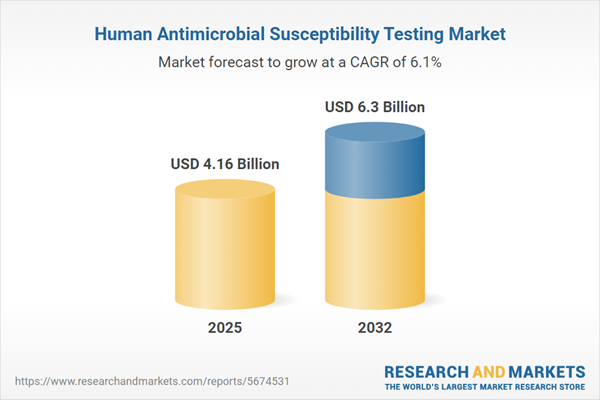Speak directly to the analyst to clarify any post sales queries you may have.
The human antimicrobial susceptibility testing market is evolving as healthcare organizations accelerate laboratory modernization and adapt to complex regulatory landscapes. Senior decision-makers require reliable market intelligence to inform procurement and compliance strategies and to enhance diagnostic resilience.
Market Snapshot: Human Antimicrobial Susceptibility Testing Market
The human antimicrobial susceptibility testing market is experiencing robust growth, driven by ongoing investments in diagnostic infrastructure and a mounting emphasis on managing antimicrobial resistance. Rapid, precise testing platforms have become a central requirement for modern healthcare systems, supporting faster clinical decisions and streamlined laboratory operations. As healthcare leaders face shifting regulatory pressures, the market is witnessing notable adoption of automated and digitalized laboratory solutions. These advancements deliver improved result turnaround, data accuracy, and compliance alignment, enabling laboratories to enhance both operational efficiency and infection control capabilities in an evolving global landscape.
Scope & Segmentation: Human Antimicrobial Susceptibility Testing Market
This report offers a strategic segmentation designed for executive leaders and procurement teams, supporting optimization and compliance in laboratory operations:
- Product: Benchtop instruments, walk-away systems, reagents, discs, growth media, testing kits, gradient strips, and laboratory workflow software—all essential for maximizing throughput and asset resources in contemporary labs.
- Technology: Platforms including MicroScan, Phoenix, Vitek, disk diffusion, gradient strip testing, microdilution, and molecular assays—enabling laboratories to standardize processes and address regulatory variations.
- Test Type: Automated, manual, agar-based, and broth dilution testing, offering flexible solutions to meet compliance and workflow requirements.
- Application: Clinical diagnostics, pharmaceutical research, industrial quality assurance, and academic research, reflecting the sector’s role in patient care and innovation.
- End User: Hospitals, clinics, diagnostic centers, and educational institutions, each facing specific procurement and operational challenges.
- Pathogen: Solutions tailored to fungi, gram-negative and gram-positive bacteria, Enterobacteriaceae, non-Enterobacteriaceae, and mycobacteria, supporting broad infection control strategies across healthcare environments.
- Region: Americas, Europe, Middle East & Africa, Asia-Pacific—each region reflecting diverse regulatory scenarios and procurement barriers fundamental to strategic planning.
- Company Coverage: In-depth reviews of key industry players such as bioMérieux SA, Thermo Fisher Scientific Inc., Becton Dickinson and Company, Danaher Corporation, Siemens Healthineers AG, Accelerate Diagnostics Inc., Bruker Corporation, QIAGEN N.V., F. Hoffmann-La Roche AG, and Luminex Corporation—facilitating effective supplier assessment and benchmarking.
These segmentation criteria empower executive teams to shape targeted investments, ensure regulatory alignment, and scale laboratory systems in accordance with regional and global needs.
Key Takeaways for Senior Decision-Makers
- Laboratory automation and digital platforms underpin consistent operations and enable agility for diagnostic teams, supporting higher standards of efficiency and data integrity.
- The adoption of digital health solutions advances laboratory adaptability, boosting interoperability and strengthening responsiveness to dynamic clinical and diagnostic demands.
- Collaboration among manufacturers, clinical leaders, and regulators simplifies compliance requirements, streamlining onboarding for innovative testing technologies and reducing workflow disruption.
- Strategy customization at the regional level helps healthcare organizations tailor diagnostic solutions, ensuring compliance with diverse regulatory standards and effective response to local healthcare needs.
- Diversified sourcing methods and reinforced supplier networks increase supply chain security, helping laboratories maintain consistent access to critical diagnostics amid shifting policies or disruptions.
- Strategic use of clinical informatics within lab operations supports quality assurance and allows rapid adjustments to changing requirements or testing protocols.
Tariff Impact on the Supply Chain
Shifting U.S. tariff policies have prompted changes in procurement strategies and supply chain approaches for antimicrobial susceptibility testing. Senior leaders are adopting localized supplier partnerships, broadening sourcing networks, and strengthening cost oversight. These measures protect critical diagnostic supply availability and reduce exposure to trade and regulatory fluctuations, supporting operational continuity.
Methodology & Data Sources
Market insights are developed from direct interviews with laboratory executives, procurement professionals, and clinical experts, and are substantiated through comprehensive industry literature and market data reviews. This methodology delivers robust, data-driven support for decision-making.
Why This Report Matters
- Provides actionable intelligence to help leaders navigate technology evolution, compliance challenges, and supply chain complexities in the human antimicrobial susceptibility testing market.
- Arms healthcare and procurement stakeholders with frameworks to direct technology adoption, ensure compliance, and strengthen diagnostic readiness for the future.
- Helps organizations build greater resilience and operational flexibility as clinical diagnostics and regulatory demands continue to evolve.
Conclusion
Validated, integrated market intelligence positions senior executives to enhance laboratory resilience, reduce operational risk, and respond strategically to new diagnostic and compliance challenges.
Additional Product Information:
- Purchase of this report includes 1 year online access with quarterly updates.
- This report can be updated on request. Please contact our Customer Experience team using the Ask a Question widget on our website.
Table of Contents
3. Executive Summary
4. Market Overview
7. Cumulative Impact of Artificial Intelligence 2025
Companies Mentioned
The companies profiled in this Human Antimicrobial Susceptibility Testing market report include:- bioMérieux SA
- Thermo Fisher Scientific Inc.
- Becton, Dickinson and Company
- Danaher Corporation
- Siemens Healthineers AG
- Accelerate Diagnostics Inc.
- Bruker Corporation
- QIAGEN N.V.
- F. Hoffmann-La Roche AG
- Luminex Corporation
Table Information
| Report Attribute | Details |
|---|---|
| No. of Pages | 196 |
| Published | November 2025 |
| Forecast Period | 2025 - 2032 |
| Estimated Market Value ( USD | $ 4.16 Billion |
| Forecasted Market Value ( USD | $ 6.3 Billion |
| Compound Annual Growth Rate | 6.1% |
| Regions Covered | Global |
| No. of Companies Mentioned | 11 |









